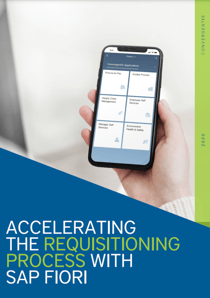As touched on in our investigation of indirect and direct procurement strategies, the procurement process is a lengthy and detailed process of many unique functions. According to SAP, these processes are broken down into the purchase requisition, supplier selection, vendor selection, purchase order, goods receipt, invoice, and payment. Upon careful inspection, you might notice that two of these processes sound very similar and might easily be interchanged by those who don’t work in procurement. Since optimizing each process is essential in your indirect procurement strategy, we wanted to highlight the differences between purchase requisitions vs. purchase orders and why your organization should focus on optimizing the purchase requisition process specifically.
Purchase Orders vs. Purchase Requisitions
A purchase requisition shouldn’t be confused with a purchase order. The differences can be specified as follows:
| Purchase Requisition | Purchase Order |
| A purchase requisition is an internal request for the purchase of a resource or service. This document is completed by an employee and received by your procurement department to kick off the purchasing process. Purchase requisitions don't typically leave your organization since they are an internal form of communication that is not legally binding. Ex. One factory within a manufacturing company finds a new type of drill that they believe will accelerate the process in which they work. This factory location fills out a purchase requisition, including the factory's address, the quantity, the description of supplies needed (300 drills), the price, the vendor, and the delivery date. This PR is then sent to the purchasing department at the head office for approval or rejection. |
A purchase order is confirmation of a charge created by your department and sent to an external supplier. This charge might be for a product or services required by your organization. Ex. Once the purchase requisition is approved, a purchase order will be created including the name of the company purchasing the drills, the description and quantity of the supply, the price, mailing address, and payment terms. The vendor can then use this document to place the order and generate an invoice for the factory. |
In the simplest terms, a purchase requisition is the request to make a purchase. The purchase order is to see the purchase through. This leads us to the next question, why are purchase requisitions and purchase orders so important?
The Importance of Purchase Requisitions and Purchase Orders
A purchase requisition is crucial in the procurement process for four key reasons.
- It is the first event that kicks off the purchasing process.
- It provides evidence that someone made the necessary communication from their department to the purchasing department.
- It serves as a safeguard to ensure that no fraud is being practiced and creates a trail for government agencies, auditors and others to view a purchasing concern.
- It is useful in reducing duplicate errors and improvements in the overall organization of purchase orders.
Suppose your business is looking to refine your purchasing strategy. This process is also one of the most beneficial to optimize in indirect procurement since multiple tasks must be completed in succession before a request can be fulfilled.
Likewise, purchase orders are also essential in managing costs and inventories. Without spending resources in the right areas, your business will have difficulty achieving business growth since decisions will need to be made with less data. Misunderstandings and disagreements that arise from an inaccurate paper trail can also harm supplier and vendor relationships if disagreements arise.
Businesses have begun to use more sophisticated electronic procurement systems to track both the purchase requisition and the purchase order process. As a result, many have seen a significant reduction in costs, greater control over company spending, and a more streamlined purchasing process that integrates directly with the rest of their financial systems.
Now that we’ve identified the differences between purchase requisitions and purchase orders, we can begin looking at optimization opportunities within the purchase requisition form.
The Purchase Requisition Format
Although the standard purchase requisitioning format varies, the purchase requisition table in SAP will include the following details:
-
Department requesting materials
-
Number of supplies requested
-
General description of the supplies
-
The legal name of the vendor
-
The expected price of the purchase
-
Name and department of the purchaser
While there are several different visual methods in which a team member can collect this information, in SAP, this information is captured by entering the transaction code ME51N or by navigating to:
Logistics -> Materials Management (which covers the entire procurement process in addition to other management functions) -> Purchasing -> Purchase Requisition -> Create
This will open a new purchase requisition screen in SAP, where you can input details, including the ones mentioned above. Depending on your organization, you may need to upload additional attachments to verify your request to purchase. These requirements may vary and are likely documented in your company policy. Upon completion, you can hit save to create the new purchase requisition.
Why Your Team Should Optimize the Purchase Requisition Process
The purchase requisition is a significant area for process optimization. This is because steps in the purchase requisition process that don’t focus on ease of use have been known to result in more workarounds, which results in increased off-contract spending initiated outside of your ERP system. Therefore, team members often initiate spend that does not comply with contract terms that have been previously negotiated. One study by industry analysts with Aberdeen proved that “eight out of 10 companies in the study reported less than a third of their transactions were found to be compliant with contract terms.” Carefully laid out policies about purchasing are often forgotten about and overlooked because steps within the purchasing process are not completed properly.
Therefore, your team can ensure greater team alignment and achieve cost efficiency, by optimizing the first step in the procure to pay process, purchase requisitioning.
How to Simplify the Purchase Requisition Process
Many SAP users have become tcode gurus, but this doesn't necessarily mean your entire team will be, especially if the number of purchase requisitions they submit is minimal. This is where the ConvergentIS Simplified Requisitioning app has allowed many employees to efficiently record the details required in the purchase requisition format without difficulty.
Corporate policies and purchasing rules are embedded directly in this application, so users will not need to consult a compliance binder. The tab that opens will prompt users through a series of fill-in boxes for information like material number (which can be saved for repeated use), quantity, price and delivery date (selected from a calendar view). Boxes can be added or removed depending on the requirements of your organization. Additionally, a purchase requisition questionnaire might be required. This can be added directly into the application to complete it as a step in the purchase requisition process. Requestors will also view the progress of submitted purchase requisitions to determine if approvals are not being held up.
The result is, users:
-
Do not need to memorize tcodes
-
Eliminate the need for constant reference to the compliance binder
-
Won’t miss information required for approval
Approvers also benefit by being able to quickly accept or reject purchase orders that have been completed with all necessary form fills.
Regardless of whether your business is large or small, purchasing can be a tedious process without the right tools. To learn more about how we've helped other companies simplify this process and how you can ensure compliance policies are adopted by your team members, we encourage you to download our free guide.


